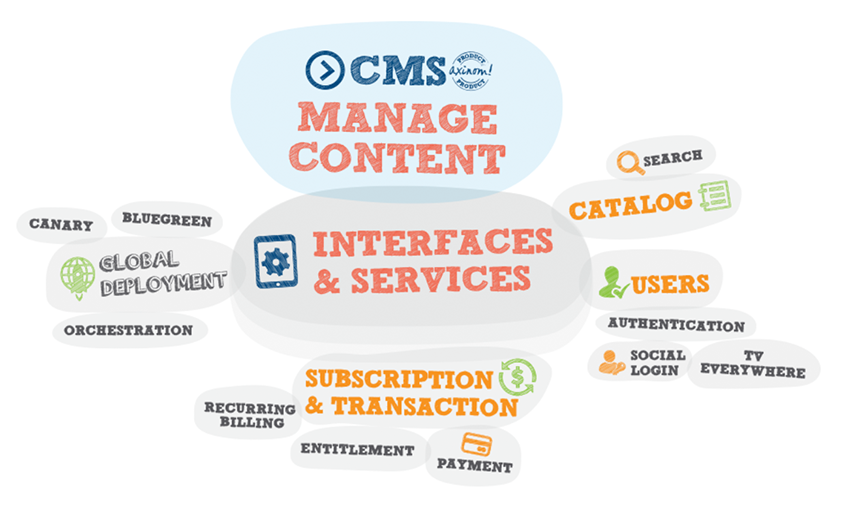THE EVOLVING OTT LANDSCAPE
Just over a decade ago, VOD services were part of the subscription package of your satellite TV or cable. At that time, one only had access to a handful of movies that could be viewed after calling-in or sending a text. As the appetite and the attitude of the consumer evolved, so did the nature of VOD services. The industry gave way to video streaming platforms that now allow the viewers to grab the remote and binge watch a TV series or catch up on any of their favorite shows no matter the device or location.
The growing user demand for flexibility, personalization, and freedom to get the content they want, how they want, and where they want is leading to a much faster cord cutting phenomena. It is evident across all major markets, visible through studies conducted by Nielsen and Ofcom in the UK and the US. The studies show that younger people are already moving away from broadcast TV and prefer streaming. The avidity for streaming is amplified by the options on offer as well. There is no shortage of OTT VOD services nowadays, and viewers have tons to choose from.
From a provider's perspective, delivering a seamless experience to a geographically distributed audience of millions brings a new set of complexities. An overabundance of OTT offerings has made the user very critical of the value and the experience on offer. Besides a sound content library, personalization, quality of experience, and service remain a significant factor for viewers in VOD service selection. A service has to offer excellent value and quality to be able to gain user loyalty.
Building for Scale and Evolution
Scaling up the services to go from thousands of viewers to millions, or expanding geographical regions involves rethinking of the service workflow in terms of traffic management, content policies, localizations, and integrations. OTT services opting for an off-the-shelf solution for their media and delivery supply chain face an issue in scalability as such solutions are usually limited in their capacity and flexibility of expansion. Providing live streams for events or linear channels needs further consideration of scalability, due to the short-term or sometimes unpredictable rise in traffic. Such scalability restrains many content owners from delivering their content to the viewers.
Issues of content localization also arise when planning to go global. Having different UIs, adding local metadata and languages, authorizing local editors to edit and review the content, and adding local services for payments, advertisements and more are all prominent localization concerns.
"OTT VOD services need to think like software providers and utilize modern development technologies. Some common methods are utilizing microservices-based architecture, having services encapsulated in containers, utilizing standard APIs. This provides the flexibility of customization and the advantage of scaling at a finger snap" says Mairika Haab, Product Owner, Axinom. "Such a planned architecture allows faster development and change cycles as well as easy deployment, integration, and full robustness."
Delivering across screens
Box TV to the smart handhelds was a critical transition that took place in the media industry. Although it made things convenient for the user, giving them many choices. For providers, it became a significant issue. Providing a seamless and similar experience throughout the screens became a challenge due to the differences between hardware and software, causing a problem of fragmentation. Contending delivery protocols, video codecs, and media formats, also add complexity to the already intricate video streaming industry.
The advancements in the digital media processing services, by multiple expert institutes in the industry, combine various technologies to offer multi-platform solutions. Such as the usage of modern standards in video encoding such as HLS, DASH with CMAF, common encryption and protection standards that span multiple DRM standards as Widevine, FairPlay and PlayReady, and support for all operating systems such as Android, iOS and more.
Personalizing with integrations
Today, to earn viewer loyalty, a service has to offer not only the exceptional quality of content but an outstanding quality of experience to the user as well. For platform owners, services that make integration and development of new features faster and allow for a personalized experience become even more crucial.
"The right content needs to reach the viewer at the press of a button," says Mairika Haab. "Any OTT business with a global focus needs a solution that can increase content workflow efficiency, and an added focus on extensibility for future expansions as this industry is proliferating and anyone not keeping up is bound to lose out."
This extensibility in managing content is essential for working with multiple content rules and operating models, compliance and licensing issues, and the using of divergent brands to cater to different types of viewers. Managing these multiple layers of complexity is one of the basic requirements for any VOD backend solution. There needs to be streamlined, automated workflows and alignment with the business aspect of the platform, i.e., what monetary models to be used to generate revenues.

Axinom CMS, with interfaces and services, allows unlimited integrations, be it external partners for content or the payment providers that are popular in a region. Through Axinom CMS, the customers can independently manage and personalize their OTT service for regions, geography, or audiences. It allows automated workflows for all processes: ingestion, transcoding, encryption, packaging, metadata management, advertisement insertions, publishing of content, and content pipeline and storage management. It can also provide each user, whether internal or third-party, with a separate dashboard, customized for specific roles and data access policies. Moreover, various policies, access restrictions, and rules can be defined within the CMS to respect and comply with the regional regulations.
With the middle-layer of interfaces and services, the customers can integrate recommendation engines and advertising providers, check entitlement, collect payments, provide easy onboarding with social media logins, gather analytics, and much more. Moreover, Axinom DRM, with support for all popular DRM standards, as well as CENC makes the security of the content a breeze.
New monetization opportunities
The end goal for any VOD service, whether newly foraying into the industry or looking to expand, is monetization. The monetization opportunities in the last few years have risen, for instance, VOD advertising alone is speculated to grow to USD 47 billion by 2023, doubling the 2018 value, according to the World Advertising Research Center (WARC). Technical complexities in exploiting these opportunities in the best possible way have risen as well.
The backend solutions need to be compatible with most common VOD revenue models to target different markets and audiences. In AVOD, it should also allow Dynamic Ad-insertion (DAI) or Client-side Ad-Insertion (CSAI) for personalized advertising.
"Being an experienced digital solutions provider in the media industry, Axinom understands that each company is different, each content piece is unique, and every market needs individual monetization strategy" adds Mairika Haab. "Our architecture allows many integrations to facilitate customer systems, payment providers, bundling opportunities, marketing promotions through vouchers, and promo codes."


